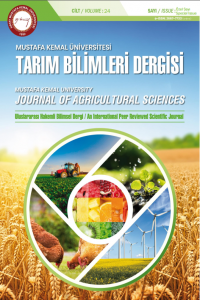The use of universal kriging interpolation technique to determine groundwater levels in dry and wet years: A case study in a semi-arid region of Mahdia in Tunisia
Öz
Aims: Overexploitation of groundwater (GW) resources leads to lowering of the water table and widespread shallow groundwater contamination, particularly in semi-arid and arid regions of the world. The region of Mahdia, located in the Sahel of Tunisia, is a semi-arid region characterized by its limited surface water and groundwater resources. Overexploitation of groundwater in some shallow aquifers has been detected lately in the region due to the increase of population and human activities. This study aimed to figure out spatial and temporal changes in groundwater elevations through using geostatistical techniques.
Methods and Results: In line with the determined objective, data from 102 groundwater observation wells, located in the Mahdia region in Tunisia, were used in this study. The Regional Commissariat for Agricultural Development of Mahdia (CRDA) provided us with the data of groundwater depth observations from 2005 to 2017, surface elevation and coordinates of the groundwater wells. The use of universal kriging, i.e. “kriging with a drift”, method allowed us to make reasonable interpretations on groundwater levels in dry and wet years. Generated maps by Jeostat Software® demonstrated that the relief of the catchment determines the groundwater divide, which controls hydrological processes in groundwater catchments. In addition, generating groundwater elevation maps for dry and wet years was subtracted and a new map was derived, i.e. difference map. Difference map indicated that overexploitation was accentuated in dry years.
Conclusions: The “universal kriging” method allowed us to obtain groundwater elevation contours and to detect groundwater-depleted areas.
Significance and Impact of the Study: Policies and economic instruments should be taken urgently to manage these overexploited aquifers and recreate the groundwater natural level particularly in dry years.
Anahtar Kelimeler
Groundwater elevation drought overexploitation kriging with drift Jeostat Software Mahdia geostatistical tools
Proje Numarası
FYL-2019-11771
Teşekkür
This Study was made possible with the occasion of the opportunity given by the Rectorate of Sousse University (Tunisia) to go to Cukurova University (Turkey), located in Adana, for 4-month. The financial support was provided by Erasmus+ mobility program. Authors would like to acknowledge to the Department of Scientific Research Projects of Cukurova University Rectorate for the financial support (Project No: FYL-2019-11771) to attend to the ICOBEN 2019 conference.
Kaynakça
- Reference 1
- Reference 2
The use of universal kriging interpolation technique to determine groundwater levels in dry and wet years: A case study in a semi-arid region of Mahdia in Tunisia
Öz
Aims: Overexploitation of groundwater (GW) resources leads to lowering of the water table and widespread shallow groundwater contamination, particularly in semi-arid and arid regions of the world. The region of Mahdia, located in the Sahel of Tunisia, is a semi-arid region characterized by its limited surface water and groundwater resources. Overexploitation of groundwater in some shallow aquifers has been detected lately in the region due to the increase of population and human activities. This study aimed to figure out spatial and temporal changes in groundwater elevations through using geostatistical techniques.
Methods and Results: In line with the determined objective, data from 102 groundwater observation wells, located in the Mahdia region in Tunisia, were used in this study. The Regional Commissariat for Agricultural Development of Mahdia (CRDA) provided us with the data of groundwater depth observations from 2005 to 2017, surface elevation and coordinates of the groundwater wells. The use of universal kriging, i.e. “kriging with a drift”, method allowed us to make reasonable interpretations on groundwater levels in dry and wet years. Generated maps by Jeostat Software® demonstrated that the relief of the catchment determines the groundwater divide, which controls hydrological processes in groundwater catchments. In addition, generating groundwater elevation maps for dry and wet years was subtracted and a new map was derived, i.e. difference map. Difference map indicated that overexploitation was accentuated in dry years.
Conclusions: The “universal kriging” method allowed us to obtain groundwater elevation contours and to detect groundwater-depleted areas.
Significance and Impact of the Study: Policies and economic instruments should be taken urgently to manage these overexploited aquifers and recreate the groundwater natural level particularly in dry years.
Anahtar Kelimeler
Groundwater elevation drought overexploitation kriging with drift Jeostat Software Mahdia geostatistical tools
Proje Numarası
FYL-2019-11771
Kaynakça
- Reference 1
- Reference 2
Ayrıntılar
| Birincil Dil | İngilizce |
|---|---|
| Konular | Ziraat Mühendisliği |
| Bölüm | Araştırma Makalesi |
| Yazarlar | |
| Proje Numarası | FYL-2019-11771 |
| Yayımlanma Tarihi | 27 Aralık 2019 |
| Gönderilme Tarihi | 27 Kasım 2019 |
| Kabul Tarihi | 17 Aralık 2019 |
| Yayımlandığı Sayı | Yıl 2019 Cilt 24 Özel Sayı: 1st Int. Congress on Biosystems Engineering 2019 |


